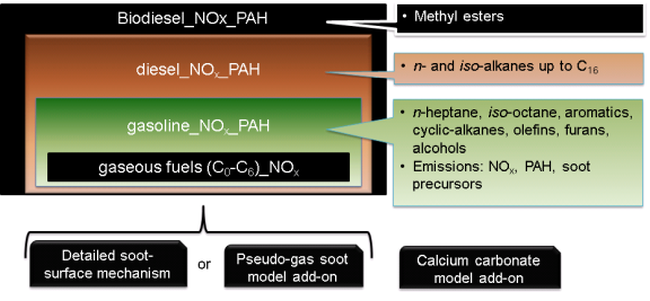The hierarchical structure of the full mechanisms is depicted in Figure 2.1: Hierarchy of the full mechanisms in the Model Fuel Library. Four full mechanisms for the gas-phase reactions are as follows.
GaseousFuels_C0-C6_NOx: This mechanism is designed for combustion simulations involving gaseous fuels, such as syngas, natural gas, etc. The mechanism includes the essential “core” chemistry that involves reactions of species with carbon number 4 (C4) and smaller. The core mechanism is the most critical component of all the mechanisms, because most components, even the large heavy components, break down during combustion and create smaller species that then undergo reactions included in the core mechanism. This mechanism can predict CO and hydrocarbon emissions up to benzene. The component mechanism for soot-precursor species, except for PAH, are included. The submechanisms for NOx emissions and sulfur emissions are also included. This mechanism also contains reactions of the additives methanol, ethanol, n-butanol, tetrahydrofuran, DME, and MTBE. This mechanism has 1381 species and 9684 reactions.
Gasoline_NOx_PAH: This mechanism is a superset of and therefore inherits all the capabilities of the GaseousFuels_C0-C6_NOx mechanism. In addition, it has reactions for components for gasoline surrogates. These include n-alkanes components up to ‘C7,’ iso-alkanes up to C8, olefins up to C6, all aromatic components, all cycloalkane components, and other components for formulating a gasoline surrogate, as listed in the mechanism ratings in the Model Fuel Library Validation Manual. The submechanism for ETFE is included. This mechanism also includes the PAH chemistry that is necessary for use with soot models. This mechanism has 2631 species and 20433 reactions.
Diesel_NOx_PAH: In addition to the capabilities of the Gasoline_NOx_PAH mechanism, larger alkanes useful for formulating surrogates for diesel and jet fuels are included in this mechanism. These include n-Alkanes up to C20 and the iso-alkanes: iso-dodecane (C12H26) and heptamethylnonane (C16H34). This mechanism has species 5242 and 68218 reactions.
Biodiesel_NOx_PAH: This is the superset of all the mechanisms in the MFL database. This mechanism extends the capabilities of the Diesel_NOx_PAH mechanism to modeling biodiesel and biodiesel/diesel blends. The components included are methyl esters that range from the small component, methylbutanoate, to heavy components, such as methyl linolenate, as listed in the mechanism ratings in the Model Fuel Library Validation Manual. This mechanism has 9382 species and 83874 reactions.
In addition to the full mechanisms for gas-phase fuel combustion and emissions, several other add-on mechanisms are available in the Library. For soot modeling, two options are available: (1) a detailed soot-surface mechanism, and (2) a pseudo-gas soot model. The detailed soot surface mechanism involves reactions for particle nucleation, growth, and oxidation that are captured in the form of a surface reaction mechanism for the soot-particle surface. This mechanism is scientifically more comprehensive than the pseudo-gas approach and it should be used when information about particle size and number is desired. However, it requires that the simulation include a particle-tracking method, such as the Method of Moments (included in Ansys Chemkin, and Ansys Forte) or the Sectional Model (included in Ansys Chemkin). The pseudo-gas soot model treats soot as a gas-phase species. The model is useful for predicting soot mass and volume fractions, but cannot provide particle number and size information. The pseudo-gas soot model does not depend on a particle tracking model in CFD simulations and requires less information about PAH kinetics than that needed by the detailed soot surface mechanism. Another add-on mechanism is for calcium carbonate particles. This is used to model the heat release by calcium particles. This mechanism was developed in part to investigate the cause behind pre-ignition knocking phenomena in advanced spark engines. The add-on mechanisms can be merged with the appropriate gas-phase full mechanism using Reaction Workbench.



